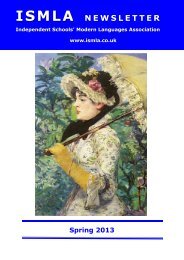Summer 2013 - The Independent Schools' Modern Language ...
Summer 2013 - The Independent Schools' Modern Language ...
Summer 2013 - The Independent Schools' Modern Language ...
Create successful ePaper yourself
Turn your PDF publications into a flip-book with our unique Google optimized e-Paper software.
Action Research: Using Skype to reduce oralexam<br />
anxiety<br />
My Year 10 Spanish group of 14 students is mixed ability for the <strong>Independent</strong><br />
context. Although all are keen to succeed, it was following a routine end of<br />
term speaking assessment that I stopped to think about why so many of<br />
them dreaded orals. To start with a measurable, I asked the girls to do the<br />
Foreign <strong>Language</strong> Classroom Anxiety Scale questionnaire (1), which explicitly<br />
assesses feelings such as fear, embarrassment and confusion generated in<br />
the language classroom. A score over 99/165 denotes a high level of anxiety,<br />
and I found that 6 out of 14 girls had scores well above this.<br />
So what could I do to help to reduce their anxiety? Naturally, we do oral and<br />
pair work in class, but I was convinced it was the absence of opportunities for<br />
sustained dialogue that was the problem, as well as the fact that they tend to<br />
gravitate towards a partner of similar confidence levels. Without the benefit<br />
of a language assistant, I needed to find a way to make them experience one<br />
-to-one conversations much more frequently, so that when oral exams next<br />
came round, they didn’t feel like such an unusual and stressful experience.<br />
This was where Skype came in.<br />
Every two weeks, girls now come to a computer suite, set up their webcams<br />
and headsets, and call each other. <strong>The</strong>y have 3-4 conversations a lesson,<br />
each lasting 10-15 minutes. Following evaluations completed after each session,<br />
I modify subsequent tasks, giving them a mixture of pre-prepared or<br />
guided conversations and spontaneous “free talking”. In a 55 minute lesson,<br />
all students speak for a good 45 minutes, only breaking when I tell them to<br />
say “¡adiós!” and to call the next person on their list. Each girl has a Spanish<br />
code name so it’s a surprise who will answer their call (in each lesson, they<br />
are sometimes the stronger and sometimes the weaker participant) and, to<br />
ensure they are not approachable by strangers online, a set of class accounts<br />
were set up by the ICT department with suitably generic names (e.g. gtyskype-01,<br />
etc).<br />
Reactions have been overwhelmingly positive, with one girl saying “it’s the<br />
most fun, relaxing Spanish lesson we do” though admittedly she was the one<br />
with the lowest FLCA score to begin with. <strong>The</strong> girl with the highest FLCA score<br />
reported for the first few sessions that it was “silly” and “no different to talking<br />
face-to-face”, but after five sessions, she admitted it was “less intimidating”<br />
and “very useful” oral exam practice. <strong>The</strong> majority response is that they<br />
feel “more comfortable” and “more confident”, find it “beneficial”, “helpful<br />
and fun”, and most commonly, that they speak “much more Spanish than in<br />
(1) Horwitz, E. K., Horwitz, M. B., & Cope, J., Foreign language classroom anxiety (1986: <strong>The</strong> <strong>Modern</strong><br />
<strong>Language</strong> Journal, 70 (2), 125-132)<br />
19



